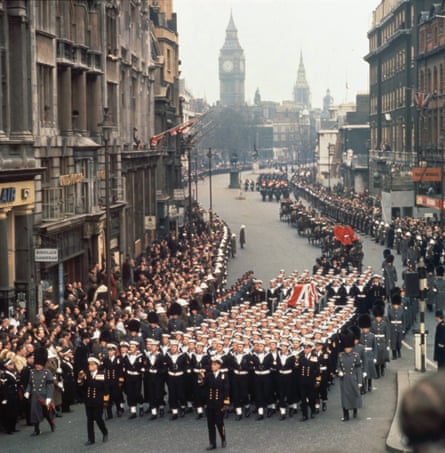
“United once again in common purpose
Sorrow shared by millions”
Michael Wall, first published in the Guardian, 1 February 1965
As during the greatest years of his life, so at his end Churchill brought together and unified in a common purpose the people of his country.
On Saturday we stood, shoulder to shoulder, from Westminster to St Paul’s, from St Paul’s to the Tower of London, along the banks of the Thames, with one mind, united with those millions who quietly watched and listened in their homes - in common sorrow, as the passage of that small, flag-draped coffin through the streets of the capital burnt into the mind a strangely sudden awareness that a great chapter had finally closed.
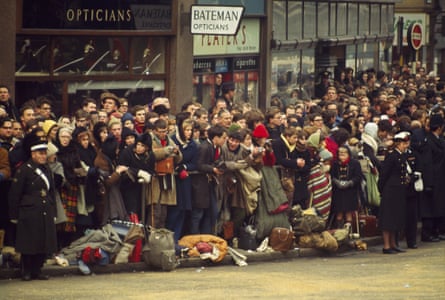
As Big Ben struck 9 45 a.m. the first poignant strains of the Funeral March were blown down Whitehall, the blocks of soldiers, sailors, and airmen with arms reversed moved forward and the great procession began its relentless progress to the Cathedral. At the same moment, the white drag-ropes of the gun carriage tightened and Churchill’s body was slowly drawn away from the buildings of the Parliament he had entered 65 years ago and which he had loved and served so well.
Measured tread
As the carriage left New Palace Yard, a single gun fired in St James’s Park; a muffled boom echoed through the hushed streets and along Whitehall all was still but for the measured, deliberate crunch of boots against the road, a steely jingle of harness, and the sad music of the march.
This article includes content provided by audioBoom. We ask for your permission before anything is loaded, as they may be using cookies and other technologies. To view this content, click 'Allow and continue'.
Numb with cold and cut through by the searing wind, the crowd, at no point thick along Whitehall, stood stock still as first the Battle of Britain air-crews, then contingents from the army, the Brigade of Guards in sombre grey greatcoats, the Royal Marines in long, khaki coats and white helmets, the scarlet cloaks and white plumes of the Life Guards, passed slowly by.
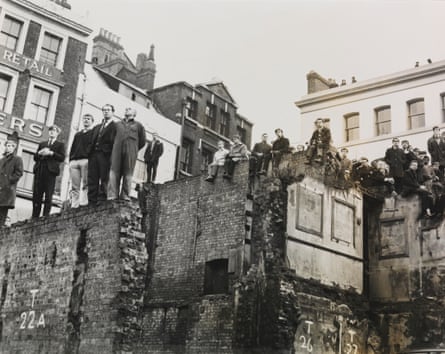
The three Chiefs of Staff followed and behind them, alone, Lord Mountbatten, Chief of the Defence Staff. We stood moved by the solemnity of the march forward, by the honour this great military procession was paying to one man. But it was the sight of the four black cushions bearing the decorations Churchill had earned and worn - carried now by four officers of the Queen’s Royal Irish Hussars - and behind them the two banners, one of the Cinque Ports and the other of Spencer-Churchill. fluttering defiantly in the wind, that brought the shock of sorrow, the sharp realisation that Churchill had gone.
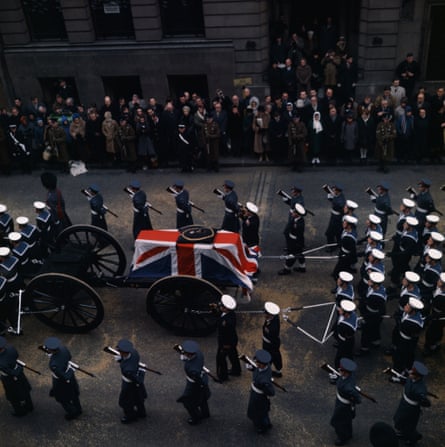
As the gun carriage, effortlessly drawn by the tight ranks of naval ratings, rolled past the Cenotaph, where Churchill had stood on so many occasions behind his Sovereign, there was flurry of colour along the pavement as French, Norwegian. Danish, Dutch—and one Icelandic—flags, carried by men who had fought in their national resistance movements, were lowered in honour and respect.
Smaller than the man
The coffin, with the black cushion bearing the emblems of the Order of the Garter, high on the heavy, grey gun carriage, seemed an incredibly small centre for this great procession, so much smaller than the man who had so often stumped the pavements of Whitehall with a dogged, determined gait between Downing Street and Parliament, and into the various Ministries which at one time or another he had ruled.

The men and the boys of the Churchill family followed on foot, all but one boy in black silk hats. Randolph the son, and Winston, the grandson, walked side by side ahead of the others. Lady Churchill and her two daughters followed in the first of the six horse-drawn coaches, obscured from sight in the dark interior; but their coachmen wore scarlet coats. Every minute the sound of gun fire was added to the strains of the funeral marches, the tread of slow-marchjng feet, the clatter of hooves, and the roll of the carriage wheels; sounds which moved along the Strand, Fleet Street, Ludgate Hill, and ceased only when the gun carriage drew up outside the great west door of St Paul’s. There, the crowds were immense, pressed tight and packed high on boxes and ladders in the side streets and thousands could gain but it glimpse of the plumes and the headdresses of the riders and the coffin.
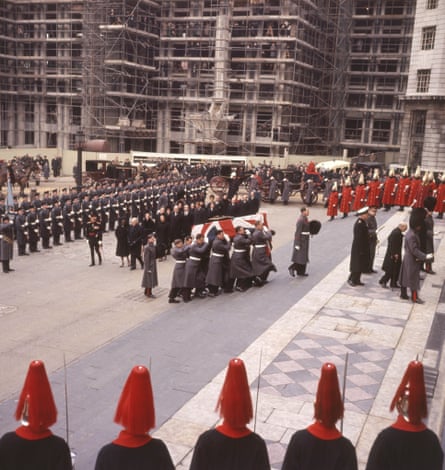
By one o’clock the great State funeral was over, the Kings and Queens, Presidents and Prime Ministers, the generals and Politicians from the world over had paid their respects, and given their thanks in the cathedral service; 7,000 service-men had lived their part in the nation’s last honour to one of the greatest leaders in its fighters.
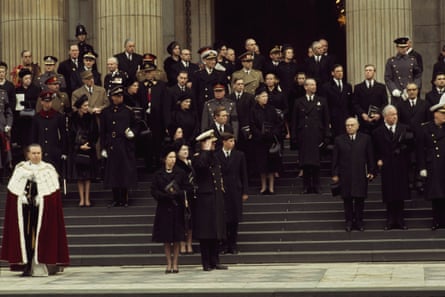
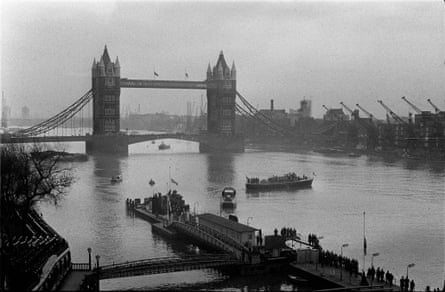
It was an ordinary black Princess hearse that drove into the central carriageway of Waterloo Station at 1 23 p.m., unescorted by soldiers or police and followed only by the large limousines with members of the Churchill family. Waiting, were 10 men from the Queen’s Royal Irish hussars, bareheaded and rigid, who, shoulder to shoulder, sidestepped up to the door of the hearse as it halted beyond them.
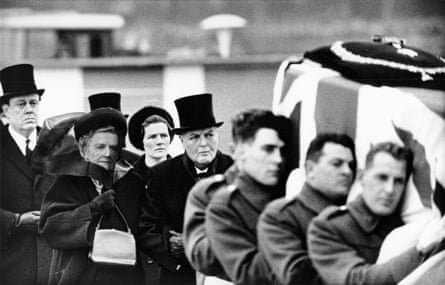
Unmistakable
With movements precise as clockwork they lifted the coffin, still draped with the Union Flag, and carrying the emblems of the Garter, and step by step bore it on their shoulders through the wide railway-van doors, placing it gently on a catafalque built inside. Motionless, holding the arm of her son, her eyes never leaving the progress of the coffin, Lady Churchill stood and watched. Behind her were the other members of Sir Winston’s family, so many of them bearing the unmistakable Churchill profile.
This article includes content provided by audioBoom. We ask for your permission before anything is loaded, as they may be using cookies and other technologies. To view this content, click 'Allow and continue'.
The crowds had been kept away: the platform was deserted, but for a few railway porters and the cameramen. The van doors were closed, the family entered the train, the guard waved his flag, and with a whistle and a belch of steam, the Battle of Britain class locomotive “Winston Churchill” moved forward.
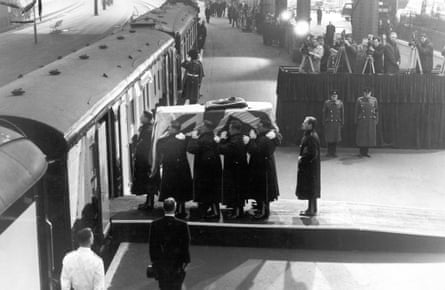
As the Pullman coaches pulled out, the station-master took off his silk hat, and porters removed their caps and two Guards officers stood at the salute until the last carriage had disappeared from sight. This was London’s last salute to Churchill.
